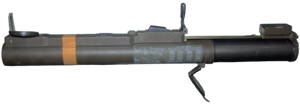| M72 LAW | |
|---|---|
 An M72 LAW in extended position | |
| Type | Anti-tank rocket-propelled grenade launcher[1] |
| Place of origin | United States |
| Service history | |
| In service | 1963–present |
| Used by | See Operators |
| Wars |
|
| Production history | |
| Designer | FA Spinale, CB Weeks and PV Choate |
| Designed | Patent filed 1963 |
| Manufacturer | |
| Specifications | |
| Mass | 2.5 kg (5.5 lb) (M72A1–3) / 3.6 kg (7.9 lb) (M72A4–7)[5] |
| Length | 630 mm (24.8 in) (unarmed) 881 mm (34.67 in) (armed) |
| Caliber | 66 mm (2.6 in) |
| Muzzle velocity | 145 m/s (480 ft/s) |
| Effective firing range | 200 m (660 ft), 220 m (720 ft) (A4–7) |
Detonation mechanism | Point-initiated, base-detonated |
The M72 LAW (light anti-tank weapon, also referred to as the light anti-armor weapon or LAW as well as LAWS: light anti-armor weapons system) is a portable one-shot 66 mm (2.6 in) unguided anti-tank weapon.
In early 1963, the M72 LAW was adopted by the U.S. Army and U.S. Marine Corps as their primary individual infantry anti-tank weapon, replacing the M31 HEAT rifle grenade and the M20A1 "Super Bazooka" in the U.S. Army. It was subsequently adopted by the U.S. Air Force to serve in an anti-emplacement and anti-armor role in airbase defense.[6][note 1]
In the early 1980s, the M72 was slated to be replaced by the FGR-17 Viper. However, the Viper program was canceled by Congress and the M136 AT4 was adopted instead. At that time, its nearest equivalents were the Swedish Pskott m/68 (Miniman) and the French SARPAC.
- ^ Rottman, Gordon L. (15 March 2011). The Rocket Propelled Grenade. Bloomsbury Publishing. ISBN 9781849081542. Retrieved 14 March 2018 – via Google Books.
- ^ "浴火重生——对越自卫反击战对我国轻武器发展的影响". 23 Sep 2014. Retrieved 5 Aug 2022.
- ^ Katz, Sam; Russell, Lee E (25 Jul 1985). Armies in Lebanon 1982–84. Men-at-Arms 165. Osprey Publishing. p. 8. ISBN 9780850456028.
- ^ "The Coconut Revolution (2001, 50min) (480x360)". youtube.com. Archived from the original on 9 March 2016. Retrieved 14 March 2018.
- ^ Cooke, Gary. "M72 Light Anti-tank Weapon System (LAW)". www.inetres.com. Gary's U.S. Infantry Weapons Reference Guide.
- ^ Mary T. Cagle "History of the TOW Missile System", page 10, U.S. Army, 1977.
Cite error: There are <ref group=note> tags on this page, but the references will not show without a {{reflist|group=note}} template (see the help page).